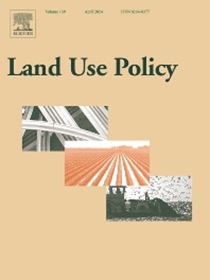Vegetation dynamics in Mainland Southeast Asia: Climate and anthropogenic influences
IF 6
1区 社会学
Q1 ENVIRONMENTAL STUDIES
引用次数: 0
Abstract
Understanding vegetation dynamics and their influencing factors is essential to regional sustainable development and ecological security. However, large-scale and long-term vegetation changes and attribution pose challenges due to temporal and quality discrepancies in multi-source remote sensing data. This study developed a research framework based on multi-source data integration and conducted a case study in Mainland Southeast Asia. By integrating Advanced Very High Resolution Radiometer (AVHRR) and Moderate Resolution Imaging Spectroradiometer (MODIS) satellite data, we generated a long-term Normalized Difference Vegetation Index (NDVI) dataset for 1982–2023. We used trend test, partial correlation analysis, and linear regression analysis to explore spatiotemporal vegetation dynamics and their links to climate and human activities. The results show: (1) the multi-year average NDVI of Mainland Southeast Asia is 0.797, with 85 % of the area exceeding 0.7, indicating robust vegetation growth across the region. The regional NDVI shows a significant increasing trend in 1982–2023, with a growth rate of 0.02 per decade. (2) The impact of rising temperatures on vegetation in Mainland Southeast Asia is mainly positive, increasing NDVI in 81 % of the area. Whereas the impact of reduced precipitation on vegetation is negligible. (3) In the quantitative attribution, temperature changes have the largest contribution to NDVI changes, contributing 70 % (0.049) to regional NDVI changes (0.056) and dominating 40 % of the area. Human activities contribute 20 % (0.014) and dominate 33 % of the area. Precipitation changes contribute 10 % (–0.007) and dominate about 5 % of the area. This study offers scientific insights and data support for understanding vegetation changes and sustainable development in Mainland Southeast Asia.
东南亚大陆植被动态:气候和人为影响
了解植被动态及其影响因素对区域可持续发展和生态安全具有重要意义。然而,由于多源遥感数据的时间和质量差异,大尺度和长期的植被变化和归因带来了挑战。本研究建立了基于多源数据整合的研究框架,并以东南亚大陆为个案进行研究。通过整合先进甚高分辨率辐射计(AVHRR)和中分辨率成像光谱辐射计(MODIS)卫星数据,生成了1982-2023年的长期归一化植被指数(NDVI)数据集。采用趋势检验、偏相关分析和线性回归分析等方法探讨了植被时空动态变化及其与气候和人类活动的关系。结果表明:(1)东南亚大陆多年平均NDVI为0.797,85% %的面积超过0.7,表明区域植被生长旺盛;1982—2023年,区域NDVI呈显著上升趋势,增长率为0.02 / a。(2)气温上升对东南亚大陆植被的影响以正影响为主,增加了81% %的植被NDVI。而降水减少对植被的影响可以忽略不计。(3)在定量归因中,温度变化对NDVI变化的贡献最大,对区域NDVI变化的贡献率为70 %(0.049),对区域NDVI变化的贡献率为40 %。人类活动占20. %(0.014),占33. %。降水变化贡献10 %(-0.007),占5 %的面积。本研究为了解东南亚大陆的植被变化和可持续发展提供了科学的见解和数据支持。
本文章由计算机程序翻译,如有差异,请以英文原文为准。
求助全文
约1分钟内获得全文
求助全文
来源期刊

Land Use Policy
ENVIRONMENTAL STUDIES-
CiteScore
13.70
自引率
8.50%
发文量
553
期刊介绍:
Land Use Policy is an international and interdisciplinary journal concerned with the social, economic, political, legal, physical and planning aspects of urban and rural land use.
Land Use Policy examines issues in geography, agriculture, forestry, irrigation, environmental conservation, housing, urban development and transport in both developed and developing countries through major refereed articles and shorter viewpoint pieces.
 求助内容:
求助内容: 应助结果提醒方式:
应助结果提醒方式:


